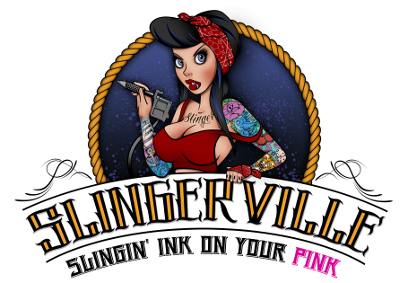 1001 Tattoo Facts: 1-20
1001 Tattoo Facts: 1-20
Article by: SlingerVille Staff
December 27, 2012
1001 Tattoo Facts: 1-20
Paul Sayce wrote one thousand
and one tattooing facts that were compiled during the last four years through
video- and audio-taped interviews with many of the world’s leading tattoo
artists and fans since 1983, when Paul started writing articles for Lionel
Titchener’s Tattoo Club Of Great Britain’s Tattoo International monthly
magazine. Other source material has been obtained from the British Tattoo
History Museum in Oxford, England in his capacity as the museum’s curator.
Today, we are going to share with you facts 1
through 20.
By Paul Sayce
1. Today in the lands of Aotearoa, New Zealand,
many Pakeha and Maori people get tattooed using modern machines in a safe
environment in regard to inks and health procedures.
2. In years gone by, the Maori elders prided
themselves, as do the young Maori of today, on the fact that some of the very
best wood carvers in the world have operated out of both the North and the
South Islands of New Zealand. And not only were elaborate patterns and spirals
carved into and onto the Maori house, weapons, war canoes and personal items,
they also carved (tattooed) themselves with small chisels made from Pounamu
(Greenstone) attached to wooden sticks.
3. The very first tattoo artist to appear on BBC TV
was Brighton-born British tattooer George Burchett, on January 27, 1938. Radio
broadcasting started as a national service in Great Britain on November 14,
1922 and the BBC television service on November 2, 1936.
4. In 1972, eight mummies (dated A.D. 1475) were
found in Qllakitsoq, Greenland. Five of the six adult women and two children
had blue-and-black tattoo marks on their faces, consisting of lines arched over
the eyes, dots on the foreheads and lines on the cheeks and beneath the chins.
Three of the adults and one of the children are thought to be the ancestors the
modern day Inuit, Eskimo people and can be seen in the Greenland National
Museum in Nuuk.
5. In the year of 1947, a mummified tattooed body
was discovered in Mongolia.
6. The very first person to become a tattoo
attraction was a man named Giolo, who went by the name of Prince Giolo. He was
born on the island of Meangis (on the northeast tip of Indonesia) and was
tattooed by one of his five wives. Records show that Giolo first exhibited
himself in London, England in 1691, a full seventy-seven years before Captain
James Cook set sail to the new world.
7. New Zealand’s Roger Ingerton moved to Sydney,
Australia in 1957 and tattooed by hand in pubs and in his living accommodation.
He started to get tattooed by Australian tattooing legend Alex Chater as well
as getting worked on by Sailor Bill on the veranda of Bill’s home studio in
Liverpool Street, Paddington (Sydney). Later, in Melbourne, he was tattooed by
possibly one of the best Australian tattoo artists of his day, Dick Reynolds,
who was known for tattooing completely freehand.
8. The people of the Micronesia Islands believed
that if they were not tattooed they would not be allowed to enter the next
world after death. This is what the Inuit people also believed.
9. The Inuit people would tattoo themselves in much
the same way as one would darn a sock, with a thread dipped in ink and pulled
through the skin like stitching. Their tattoos consisted of lines and crosses
and in some cases they were tattooed completely from knee to groin, as well as
on the arms and thighs.
10. In the islands of Samoa in the South Pacific
there were three goddesses of tattooing, Taema and sisters Sina and Sena.
11. The word in Japanese for tattoo is irezumi,
which roughly translates as “tattooing for punishment.”
12. Hawaiian people used to tattoo their tongues
with dots as a state of mourning, when a loved one passed away.
13. Henry J. Topping, the one-time husband of film
star Lana Turner and once proud owner of the New York Yankees baseball team,
had both his arms tattooed.
14. Thomas Lipton (later Sir Thomas) had a tattoo
of a sailing yacht tattooed on his chest. Lipton, of course, was the famous British
tea merchant.
15. During the Second World War, the King of
Norway, Haakon VII, relocated to England so that he could lead his country’s
war effort through exile. While he was in London he was tattooed by one of the
capital’s finest tattooers, Tom Riley, who tattooed at 432 The Strand.
16. Tattoo Jack of Liverpool, England worked in
Boaler Street in the 1940s and was believed to have been the first tattoo
artist in England to use other people’s designs. British tattooers of the time
usually tattooed on designs that they drew themselves.
17. Hugh O’Brian, tough guy actor, star of over
forty-five feature films and best loved for his role in the television series The Life and
Legend of Wyatt Earp, had a skull and crossbones tattooed on the
inside of his right forearm, which he got when he was in the U.S. Marine Corps.
18. In June of 1914, Irish woman Queenie Morris
appeared with both legs and arms completely covered in tattoos at London’s
Earls Court. Her tattooist was the famed Prof. Joseph Kilbride.
19. In 1966, Huck Spaulding of Spaulding and Rogers
tattoo supply company fame stated that there would be a tattoo shop on every
street corner one day.
20. Wally Hammond, famed Australian tattoo artist, passed away on September seventh, 1992 in Noosa in the Sunshine State. Wally was one of the first to set up a professional tattooing shop on the Kings Cross of Sydney, New South Wales and was indeed a tattoo artist whom many other tattoo artists looked up to.
Source: http://tattooroadtrip.com/tattoo-facts-1-20/
Login to comment
Comments
No comments yet.

